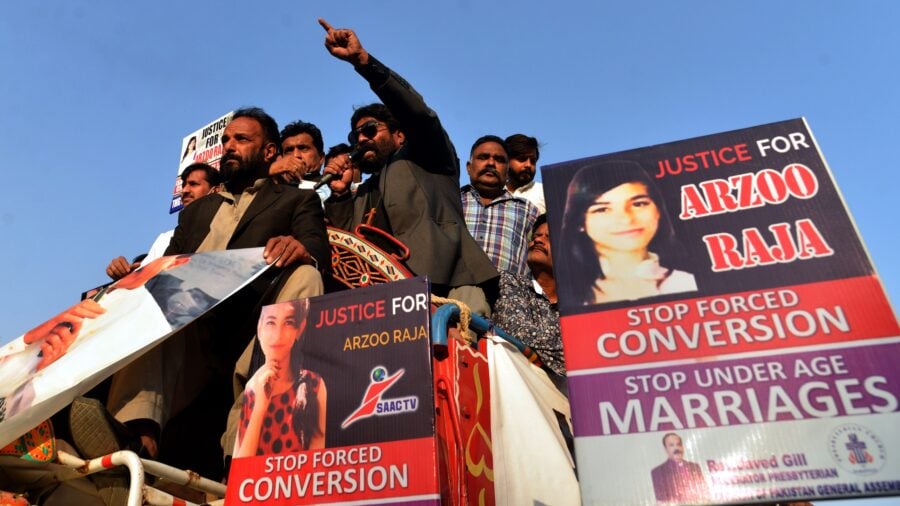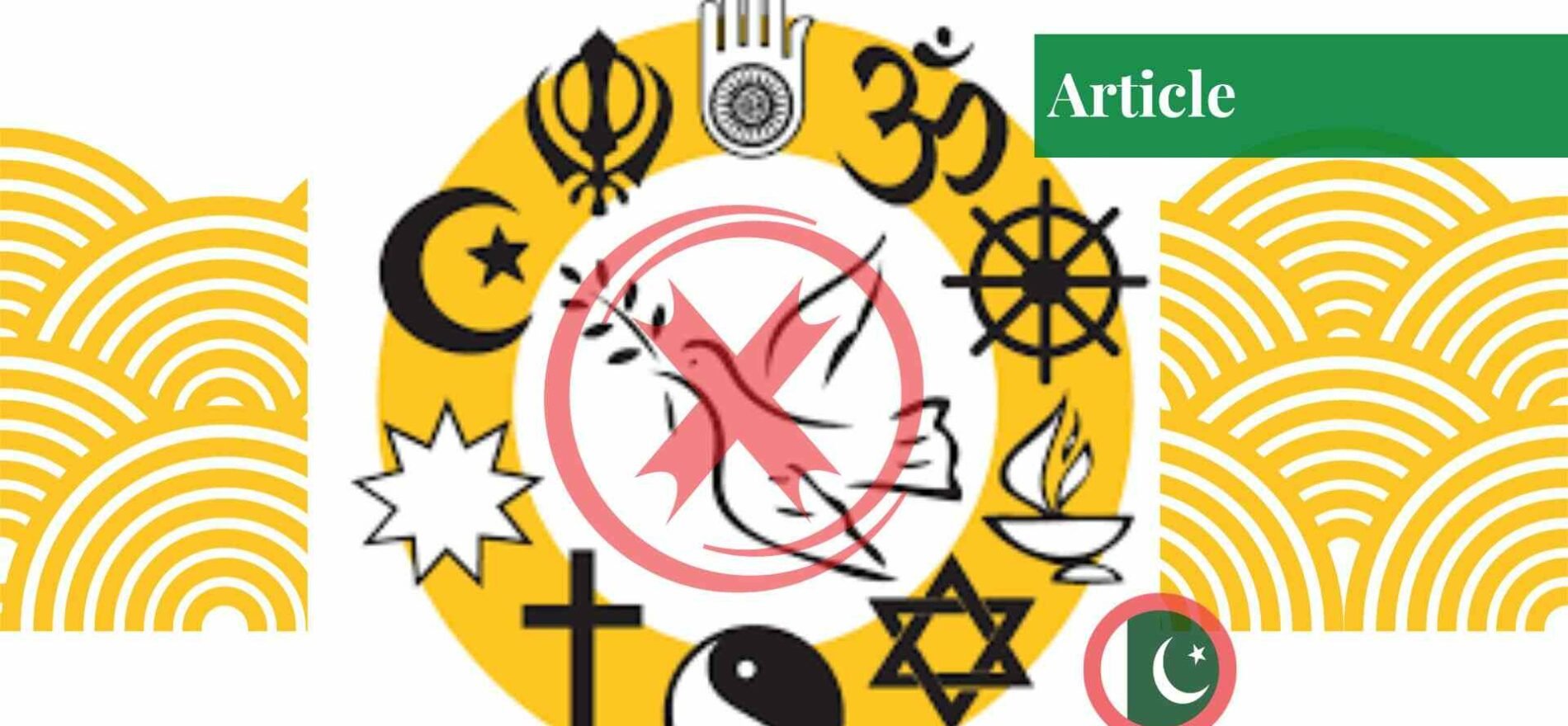Sadaf Shabbir is a student of International Relations at the University of Karachi. She is a proud bibliophile analyzing world politics and contemporary events through the lens of gender studies. She focuses on unveiling the sexism and gender biases engraved in each field and discovered writing as her way to disseminate her thoughts to the world. For her, writing serves to revamp the way people interpret certain events in society.
Introduction
In forced conversions, perpetrators are men and those converted are women and girls who are usually abducted, forcefully converted, before being married off to their kidnappers. Intersectionality between forced conversions, rapes, and early marriages has been typical and can be traced in almost each case. According to the estimates reported by The Movement for Solidarity and Peace (MSP), 1000 women and girls face this violence every year in Pakistan, with the numbers expected to be higher because of the underreported cases related to forced conversions in Pakistan.
Not only that, these women and girls are also forced into other forms of sexual violence, prostitution and human trafficking. This goes to show how the entrenched influence of the religious clerics in politics and decision-making mechanisms of Pakistan has exacerbated the already worsening standing of minorities. Out of many, one culmination was seen when the ‘Protection of Minorities Bill’ was made controversial by the propaganda waged by conservative mindsets in the parliament.

The bill was ultimately declared as something desecrating the sacred teachings of Islam and this is how with the undeterred efforts made by Islamist elements in politics of Pakistan, the bill was repealed. Most of those converted are either tied up with bonded labor or belong to the scheduled castes; these factors further expose them to forced conversions.
It’s farcical how laws in Pakistan are considered the most fragile. For instance, bonded labor in Pakistan was criminalized in 1992 under the Bonded System Abolition Act 1992, but the implementation of it has yet to be seen. Similarly, the draconian laws such as those of blasphemy combined with the ineffective judicial precedence in relation to forced conversions remain dangling like a sword because of which the conviction rate shows a disappointing picture.
Low Conviction Rates
Researchers and academics have used various and distinct means to evaluate the dimensions of violence against minorities in Pakistan and the phenomenon of forced conversions in particular remains an area of research over which much diverse studies have been conducted. Some of the most credible and reliable accounts to explore the gravity of the crime can be better understood with the scholarly writings given by Reuben Ackerman in her research report ‘Forced Conversions and Marriages in Sindh, Pakistan, 2018’ published by Edward Cadbury Centre, University of Birmingham.
While Pakistan remains a signatory to International Covenant on Civil and Political Rights (ICCPR), has signed and ratified Convention on the Elimination of Discrimination Against Women (CEDAW) and Child Rights Convention (CRC), Ackerman’s report highlights the gruesome violations of the above. Ackerman aptly evaluates the reasons of the low conviction rates and how the judicial process works on the initial stage. Ackerman argues that the biases in police have been blatant, making the clout of impunity for the perpetrators of forced conversions even more entrenched.
Most of the time, the victim’s family is denied the right to record the First Information Report (FIR), hammering down the first way to go for any justice. The biggest flaw in the justice system of Pakistan which Ackerman pointed out was that of the judicial proceedings. During the trial, the victims are often kept under the custody of the kidnappers who further threaten them to give their statements in favor of the perpetrator.
The Typical Pattern of Forced Conversions
A factsheet compiled by Naumana Suleman and published by the National Commission for Justice and Peace Pakistan argued that when it comes to changing one’s religion in Pakistan, theoretically speaking, there’s no restriction to that but changing religion means converting to Islam only and not vice versa.
Suleman traced out the typical pattern which is prevalent in most of the cases of forced conversions in Pakistan. First, most of those abducted are women including minors who are forcefully married off. The families are denied the right to even catch a glance of the victim and the courts’ precedence and verdicts go into the favor of the culprits who belong to the majority religion and hailing from influential backgrounds. The factsheet also gave the accounts of government officials even on the municipal level forcing their fellows belonging to religions other than the majority one to convert or else be threatened to lose their jobs.
Maliha Zia and Riffat Butt in their report, Minority Women of Pakistan: A Case of Double Jeopardy published by the Aurat Foundation, November 2012, have drawn attention upon the double-edged sword minorities women face. The report discussed how Pakistan’s government has never prioritized to tackle the violence faced by women. The report further highlighted that the deliberate criminal negligence of those in power and the lack of political will combined with cumbersome and androcentric institutions have further jeopardized the existence of women in Pakistan.
It is to be noted that the state has failed to enact effective laws when it comes to containing domestic violence, social protection and child rights. On the social level, the harmful customary practices and traditions against women remain incessant. Honor killings, child marriages, forced marriages, acid attacks, vani, swara are rarely discussed on the political platforms in Pakistan because most of those in power also maintain such grim crimes back in their homes.
The Legal Landscape
The report submitted by ‘Nonviolent Radical Party, Transnational and Transparty’ (having consultative status with UN ECOSOC) during the 28th session of Universal Periodic Review (review of the Human Rights record of all the member states of UN), highlights the role played by Pakistan’s religious institutions and political parties in aggravating the intensity of the crimes of forced conversions in Pakistan.
For the conversion to have a legal status, the certificate is issued by the local religious institutions, mainly mosques and seminaries. These certificates are considered credible under the law of Pakistan, but the report critically analyzes the nature of the certificates. The conversion certificates which are issued and produced by the religious institutions before the courts do not often thoroughly investigate the nature of the conversion and disregard the age of the converted. Most of the time, the certificate is issued only on the statement of the abductor.
Minority Rights Group International, a leading human rights organization working across 50 countries, published a report to enhance the understanding of the different facets responsible for the institutionalized exclusion of minorities of Pakistan. Authored by Dr. Iftikhar H. Malik, the research report describes the concept of “minority-majority relationship in Pakistan.” First, there has to be a clear understanding that Pakistan is an Islamic country but is dominated by the Sunni sect. In this way, those Muslim groups who don’t belong to the “dominating sect” ultimately are considered minorities.
According to Dr. Iftikhar, now this dominating faction or the majority is hell bent to mold the minorities on its own terms. On the other hand, minorities keep striving for the preservation of their distinct identities. “Exclusionary Nationhood” is another concept elaborated in the report; from the objective resolution to the era of General Zia-ul-Haq, all the laws and constitutional arrangements have brought inequality on the minorities.
The report has also tried to link the religious hate crimes against Hindus in particular with the “communalization of Indo-Pakistani politics and their inter-state rivalries.” Whenever the relation between the two nuclear arch-rivals is flared up, the religious and communal hatred against Hindus in Pakistan gains momentum.
Connection with Patriarchy
Naziha Syed Ali reveals the plight of women in Pakistani society and how such an oppression prevalent throughout the country makes young women and minors susceptible to this heinous crime. She notes that when it comes to victims of forced conversions, most of them are women of immature age. Why are mature women not targeted? Psychologically speaking, the minors are easy to persuade and can be threatened to a wider extent. When the girls are kidnapped, they are repeatedly raped until they lose their will of resistance only to falsely admit that they converted with their consent.
In addition, these girls, if returned to home, are left with fewer choices. First, they can’t risk the lives of their families at the hands of the criminal who usually is privileged in terms of gender and even religion, belonging to the majority one. Second, their families refuse to accept them as they are now considered “defiled.” In such a precarious situation, the girl prefers to live with her abductor with whom too she’s never fully assimilated.
The patriarchal religious interpretations have always left women shunned, while men keep advancing their interests by distorting and taking advantage of both religion and gender.
If you want to submit your articles, research papers, and book reviews, please check the Submissions page.
The views and opinions expressed in this article/paper are the author’s own and do not necessarily reflect the editorial position of Paradigm Shift.



















